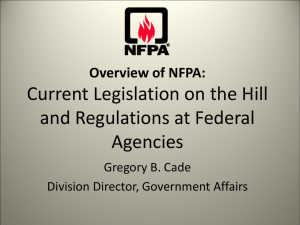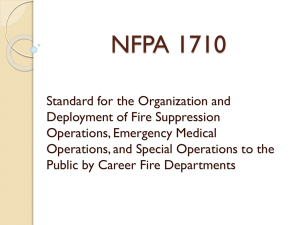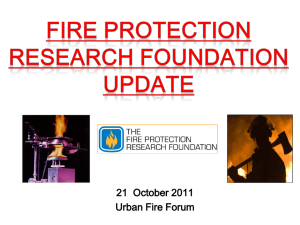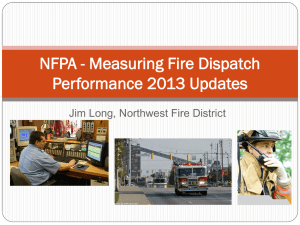FCIA San Antonia Presentation
advertisement
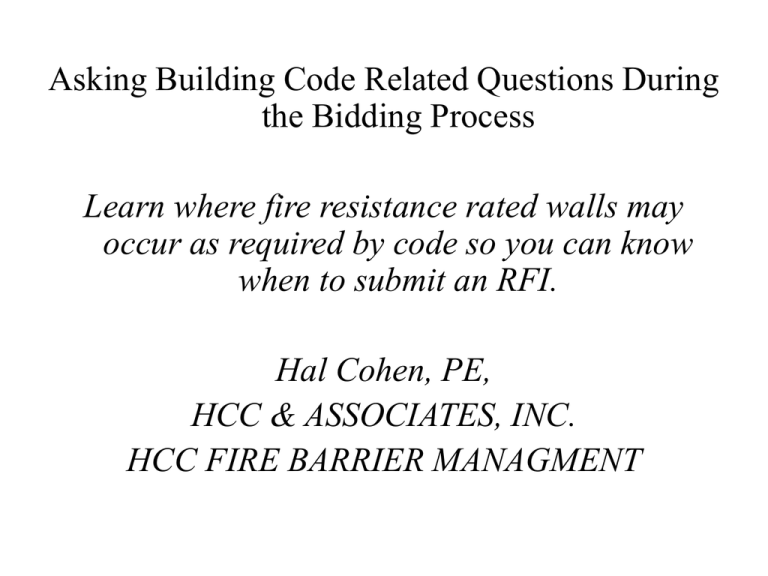
Asking Building Code Related Questions During the Bidding Process Learn where fire resistance rated walls may occur as required by code so you can know when to submit an RFI. Hal Cohen, PE, HCC & ASSOCIATES, INC. HCC FIRE BARRIER MANAGMENT SOCIETY OF FIRE PROTECTION ENGINEERS ROOTS STARTED IN 1950 ADVANCE THE SCIENCE AND PRACTICE OF FIRE PROTECTION ENGINEERING 75 CHAPTERS Texas DALLAS-FT. WORTH CHAPTER President: Mark Hasenmyer, P.E. Chapter Support Council Liaison: Michael Shannon Board Of Directors Liaison: Jack Poole HOUSTON CHAPTER President: Robert S. Hicks, P.E. Chapter Support Council Liaison: Michael Shannon Board Of Directors Liaison: Jack Poole AUSTIN / SAN ANTONIO CHAPTER President: Scott Stookey Chapter Support Council Liaison: Michael Shannon Board Of Directors Liaison: Jim Begley Student Chapters Cal Poly, San Luis Obispo, California, USA Eastern Kentucky University, Richmond, Kentucky USA Oklahoma State University, Stillwater, Oklahoma USA The University of Maryland, College Park, Maryland USA The University of New Haven, West Haven, Connecticut USA The University of North Carolina Charlotte, Charlotte, North Carolina USA The University Of Texas At Austin, Austin, Texas USA Virginia Tech, Blacksburg, Blacksburg, Virginia USA Worcester Polytechnic Institute, Worcester, Massachusetts USA QUALITY ASSURANCE • FM APPROVED IN ACCORDANCE WITH FM STANDARD 4991 – APPROVAL OF FIRESTOP CONTRACTORS • UL QUALIFIED FIRESTOP CONTRACTOR • FCIA MEMBER IN GOOD STANDING • TAKE OUT “BY TRADE” IN THE SPECS (UNION ISSUES) AIA CHAPTERS IN TEXAS (PARTIAL) • • • AIA Abilene Web: https://texasarchitects.org/v/chapter-detail/AIA-Abilene/4n/ AIA Amarillo Web: www.aia-amarillo.org AIA Austin Phone: 512-452-4332 E-mail: sally@aiaaustin.org Web: www.aiaaustin.org • • • • • • • AIA Corpus Christi (361) 887-2124 Web: www.aiacorpuschristi.org AIA Dallas 214-742-3242 E-mail: info@aiadallas.org Web: www.aiadallas.org AIA San Antonio 210-226-4979 210-226-3062 torrey@aiasa.org Web: www.aiasa.org AMERICAN INSTITUTE OF ARCHITECTS • Based in Washington, D.C., the AIA has been the leading professional membership association for licensed architects, emerging professionals, and allied partners since 1857. • With nearly 300 state and local chapters, the AIA serves as the voice of the architecture profession and the resource for our members in service to society. • he American Council of Engineering Companies (ACEC) is the voice of America's engineering industry. Council members – numbering more than 5,000 firms representing more than 500,000 employees throughout the country – are engaged in a wide range of engineering works that propel the nation's economy, and enhance and safeguard America's quality of life. These works allow Americans to drink clean water, enjoy a healthy life, take advantage of new technologies, and travel safely and efficiently. The Council's mission is to contribute to America's prosperity and welfare by advancing the business interests of member firms. ACEC TEXAS (PARTIAL) • • • • • ACEC Central Texas Chapter Meeting ACEC Dallas Chapter Meeting ACEC El Paso Chapter Meeting ACEC Houston ACEC San Antonio Chapter Meeting/Holiday Reception • ACEC Tarrant County Chapter Meeting NFPA CODE/ STANDARD IDENTIFYING AREA SAMPLE REQUEST FOR INFORMATION (RFI) WORDING NFPA 13, Standard for the Installation of Sprinkler Systems Look for notes on the fire protection, plumbing, and/or sprinkler drawings that state that sprinkler protection is not to be provided in a certain area. These areas might include high voltage electrical equipment rooms or vaults or concealed spaces that do not require sprinkler protection but might require enclosure in fire rated construction. The note on sheet “x” states that sprinkler protection is not required in area “y”. Is area “y” enclosed in fire rated construction and do the penetrations need to be properly firestopped? NFPA CODE/ STANDARD IDENTIFYING AREA NFPA 20, Standard for the Installation of Stationary Pumps for Fire Protection Some designers are not aware that the room containing the fire pump needs enclosure in fire rated construction. SAMPLE REQUEST FOR INFORMATION (RFI) WORDING Does the fire pump room need enclosure in fire rated construction in accordance with NFPA 20, Standard for the Installation of Stationary Pumps for Fire Protection, and do the penetrations need to be properly firestopped? 4.12.1.1.1 Fire pump units serving high-rise buildings shall be protected from surrounding occupancies by a minimum of 2-hour fire-rated construction or physically separated from the protected building by a minimum of 50 ft (15.3 m). NFPA CODE/ STANDARD NFPA 30, Flammable and Combustible Liquids Code IDENTIFYING AREA Look for room descriptions that suggest flammable and combustible liquids might be stored in them. These rooms might include engineering maintenance shops, hazardous waste collection rooms, and chemical, fuel, or paint storage rooms, and might require enclosure in fire rated construction. SAMPLE REQUEST FOR INFORMATION (RFI) WORDING Room “x” might include the storage and use of flammable and combustible liquids. Does the room need enclosure in fire rated construction as required by NFPA 30, Flammable and Combustible Liquids Code, and do the penetrations need be properly firestopped? NFPA CODE/ STANDARD NFPA 30A: Code for Motor Fuel Dispensing Facilities and Repair Garages IDENTIFYING AREA Some parking garages and/or vehicle maintenance bays might include fuel dispensing capabilities or the repair of equipment. These rooms sometimes require enclosure in fire rated construction. SAMPLE REQUEST FOR INFORMATION (RFI) WORDING Room “x” might be used for fuel dispensing or vehicular maintenance and repair. Does the room need enclosure in fire rated construction in accordance with NFPA 30A: Code for Motor Fuel Dispensing Facilities and Repair Garages, and do the penetrations need to be properly firestopped? 7.3.6 Fuel Dispensing Areas Inside Buildings. 7.3.6.1 The fuel dispensing area shall be separated from all other portions of the building by walls, partitions, floors, and floor–ceiling assemblies having a fire resistance rating of not less than 2 hours. 7.3.6.4 Openings for ducts in fire-rated interior partitions and walls shall be protected by listed fire dampers. Openings for ducts in fire-rated floor or floor–ceiling assemblies shall be protected with enclosed shafts. Enclosure of shafts shall be with wall or partition assemblies having a fire resistance rating of not less than 2 hours. Openings for ducts into enclosed shafts shall be protected with listed fire dampers. NFPA CODE/ STANDARD IDENTIFYING AREA SAMPLE REQUEST FOR INFORMATION (RFI) WORDING Room “x” is identified as a laboratory. Does the expected quantities of flammable and combustible liquids warrant the need to enclose the room in fire rated construction as required by NFPA 45, Standard on Fire Protection for Laboratories Using Chemicals, and do the penetrations need to be properly firestopped? 5.2 Maximum Area of Laboratory Units. The maximum area of a laboratory unit shall be determined by the fire hazard classification and the construction of the laboratory unit, as shown in Table 5.1.1. NFPA 45, Standard on Fire Protection for Laboratories Using Chemicals Look for room descriptions that state “laboratory.” The quantities of flammable and combustible liquids that are stored and used in a laboratory typically determine those areas that might require enclosure in fire rated construction. NFPA CODE/ STANDARD NFPA 58, Liquefied Petroleum Gas Code IDENTIFYING AREA Liquefied petroleum gas (LPG) is not typically stored inside rooms. However, these rooms typically require enclosure in fire rated construction. SAMPLE REQUEST FOR INFORMATION (RFI) WORDING Room “x” is identified as storing liquefied petroleum gas (LPG). Does the room need enclosure in fire rated construction as required by NFPA 58, Liquefied Petroleum Gas Code, and do the penetrations need to be properly firestopped? Construction of Attached Structures. 10.3.1.3 Common walls of structures shall have the following features: Construction of Rooms Within Structures. 10.3.2.6 Fire resistance rating of at least 1 hour NFPA CODE/ STANDARD IDENTIFYING AREA NFPA 70, Rooms that are identified as National electrical vaults and high voltage Electrical Code® equipment rooms typically require enclosure in fire rated construction. Although oftentimes seen, typical electrical equipment rooms do not need enclosure in fire rated construction if the floor penetrations are properly firestopped. The deciding factor is typically the size and type of transformer that might be installed in the room. SAMPLE REQUEST FOR INFORMATION (RFI) WORDING Does the electrical equipment require enclosure in fire rated construction? NFPA 70 requires the room to be enclosed in the electrical equipment room if the room’s transformer is rated over 112½-kVA, unless (1) The transformer includes a Class 155 or higher insulation system and is separated from combustible material by a fire-resistant, heatinsulating barrier or by not less than six feet horizontally and twelve feet vertically, or, (2) The transformer includes a Class 155 or higher insulation system and is completely enclosed except for ventilating openings. A Electrical Vaults. Where an electrical vault is required or specified for conductors and equipment operating at over 600 volts, nominal, the following shall apply. 1 Walls and Roof. The walls and roof shall be constructed of materials that have adequate structural strength for the conditions, with a minimum fire rating of 3 hours. For the purpose of this section, studs and wallboard construction shall not be permitted. NFPA CODE/ STANDARD NFPA 72, National Fire Alarm and Signaling Code IDENTIFYING AREA Fire command centers and similar rooms that include full time personnel who monitor fire and security rooms typically need enclosure in fire rated construction. SAMPLE REQUEST FOR INFORMATION (RFI) WORDING Does the fire/security command center need enclosure in fire rated construction in accordance with NFPA 72, National Fire Alarm and Signaling Code, and do the penetrations need to be properly firestopped? 26.4.3 Facilities 26.4.3.1The proprietary supervising station shall be located in either of the following: (1) Fire-resistive, detached building (2) A fire-resistive room protected from the hazardous parts of the building NFPA CODE/ STANDARD NFPA 75: Standard for the Fire Protection of Information Technology Equipment IDENTIFYING AREA SAMPLE REQUEST FOR INFORMATION (RFI) WORDING Computer equipment rooms and Room “x” is identified as a similar rooms might need computer equipment room. Does enclosure in fire rated the room need enclosure in fire construction. Risk analysis is rated construction as required by oftentimes used to determine NFPA 75, Standard for the Fire those walls requiring a fire Protection of Information rating. Technology Equipment, and do the penetrations need to be properly firestopped? 5.1.2 Protection for the building housing the information technology equipment area shall be provided where it is subject to damage from external exposure. 5.1.3 The information technology equipment area shall be separated from other occupancies within the building, including atria or other open-space construction, by fire-resistant-rated construction. 5.1.3.1 The information technology equipment room shall be separated from other occupancies in the information technology equipment area by fire-resistant-rated construction. 5.1.3.2 The fire resistance rating shall be commensurate with the exposure but not less than 1 hour for both. 5.1.3.3 The fire-resistant-rated enclosures shall extend from the structural floor to the structural floor above or to the roof. NFPA CODE/ STANDARD NFPA 82, Standard on Incinerators and Waste and Linen Handling Systems and Equipment IDENTIFYING AREA Chutes, the rooms at the top and bottom of the chutes, and chute loading rooms might require enclosure in fire rated construction. These include trash and linen chutes. The size of the room (i.e., used for storage or some other use) is an indicator of an area that might need enclosure in fire rated construction. SAMPLE REQUEST FOR INFORMATION (RFI) WORDING Does the collection room at the bottom of the linen chute and any chute loading room need enclosure in fire rated construction in accordance with NFPA 82, Standard on Incinerators and Waste and Linen Handling Systems, and do the penetrations need to be properly firestopped? 5.2.7.1 Incinerators shall be enclosed within a room separated from other parts of the building by walls, partitions, floor, and floor-ceiling assemblies constructed of noncombustible material and having a fire resistance rating of not less than 2 hours and used for no other purpose. 6.2.5.1.1 Every chute intake shall be in a room that is separated from the other parts of the building by walls, partitions, floors, and floor-ceiling assemblies having a fire resistance rating of not less than the required rating of the chute enclosure as specified in 6.2.3.1. 6.2.5.1.3 Where chute intake rooms are protected by automatic sprinklers, the room shall be enclosed in a minimum of 1-hour fire resistance-rated construction. NFPA CODE/ STANDARD NFPA 88A, Standard for Parking Structures IDENTIFYING AREA SAMPLE REQUEST FOR INFORMATION (RFI) WORDING Do the parking areas that are connected to the building need enclosure in fire rated construction in accordance with NFPA 88A, Standard for Parking Structures, and do the penetrations need to be properly firestopped? Parking structures are sometimes attached or located below buildings that are used for other purposes (i.e., office or stores). The parking area sometimes needs to be separated from the remaining building areas (including the elevator lobby) by fire rated construction. 5.2.1 Those parts of parking structures located within, immediately below, attached to, or less than 120 inches from a building used for any other purpose shall be separated by walls, partitions, floors, or floor–ceiling assemblies having fire resistance ratings of not less than 2 hours. 5.2.4 Offices or other similar spaces that are related to the operation of the parking structure and are less than 3000 ft2 in area, other than cashier or attendant booths, shall be separated from parking areas by walls or partitions that resist the passage of smoke. 38.1.3.2.2 Openings in the fire barrier shall not be required to be protected with fire protection–rated opening protectives in enclosed parking structures that are protected throughout by an automatic sprinkler system, or in open parking structures, provided that all of the following conditions are met: IDENTIFYING AREA NFPA CODE/ SAMPLE REQUEST FOR STANDARD INFORMATION (RFI) WORDING NFPA 101, As a general rule, an area that is Room “x” appears to have a degree Life Safety considered a “greater hazard” of hazard greater than the generally Code® than the surrounding building occupancy. Does the predominant area might require room need to be enclosed in fire enclosure in fire rated construction especially if the rated construction in accordance areas are not sprinkler protected. with NFPA 101, Life Safety These areas might include boiler Code®, and do the penetrations equipment rooms or other room need to be properly firestopped? where fuel-fired equipment exists, large storage rooms, etc. 8.7 Special Hazard Protection. 8.7.1.1 Protection from any area having a degree of hazard greater than that normal to the general occupancy of the building or structure shall be provided by one of the following means: (1) Enclosing the area with a fire barrier without windows that has a 1-hour fire resistance rating in accordance with Section 8.3 (2) Protecting the area with automatic extinguishing systems in accordance with Section 9.7 (3) Applying both 8.7.1.1(1) and (2) where the hazard is severe or where otherwise specified by Chapters 11 through 43 NFPA CODE/ STANDARD NFPA 110, Standard for Emergency and Standby Power Systems IDENTIFYING AREA SAMPLE REQUEST FOR INFORMATION (RFI) WORDING Rooms that include emergency Room “x” appears to include the generators might require emergency generator. Does the enclosure in fire rated room need enclosure in fire rated construction. construction in accordance with NFPA 110, Standard for Emergency and Standby Power Systems, and do the penetrations need to be properly firestopped? 7.2.1.1 The EPS room shall be separated from the rest of the building by construction with a 2-hour fire resistance rating. NFPA CODE/ STANDARD NFPA 232, Standards for the Protection of Records IDENTIFYING AREA Rooms that are contain rolling file storage units, computer tape storage equipment, and similar rooms that appear to be used for the long term storage of records might need enclosure in a fire rated construction. SAMPLE REQUEST FOR INFORMATION (RFI) WORDING Room “x” appears to be used for long term or permanent storage of records. Does the room need enclosure in accordance with NFPA 232, Standards for the Protection of Records, and do the penetrations need to be properly firestopped? 4.2.1 The responsible party shall establish an acceptable level of risk tolerance for both limited and catastrophic events. 4.5.1 As part of the fire risk evaluation of Section 4.4, the responsible party shall include the potential for the records to be destroyed by a fire that initiates in an area external to the operations. IDENTIFYING AREA NFPA CODE/ SAMPLE REQUEST FOR STANDARD INFORMATION (RFI) WORDING NFPA 909, Some designers are not aware The building is used as a museum, Code for the that this code exists. The library or place of worship. Is Protection of requirements for fire rated NFPA 909, Code for the Protection Cultural construction vary and are of Cultural Resource Properties — Resource oftentimes determined through a Museums, Libraries, and Places of Properties — risk analysis. As the name Worship, applicable and is any Museums, implies, the code is applicable to additional fire rated construction Libraries, and museums, libraries and places of required? Places of worship. Worship 4.1 General. The governing body of the cultural resource property shall adopt protection goals and objectives that reflect the acceptable level of loss for both of the following: (1)Items of cultural significance; (2) Interruption of service to the client community
